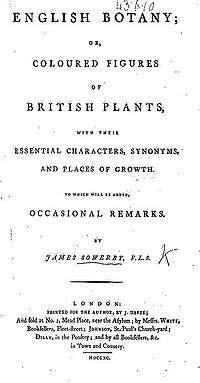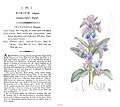English Botany
English Botany was a major publication of British plants comprising a 36 volume set, issued in 267 monthly parts over 23 years from 1791 to 1814. The work was conceived, illustrated, edited and published by the botanical illustrator and natural historian, James Sowerby. The brief, but formal descriptions were mostly supplied by the founder of the Linnean Society, Sir James Edward Smith. Initially Smith declined to have his name associated with the work as he considered his professional co-operation with a mere artisan such a Sowerby might degrade his standing in higher circles. However, following the phenomenal public success and general acceptance by the professional class of the work he insisted that the title page of the fourth and succeeding volumes include his name. The work, however, continued to be generally referred to as "Sowerby's Botany".
 Title page from the book | |
| Author | James Sowerby, James Edward Smith & others |
|---|---|
| Illustrator | James Sowerby |
| Country | England |
| Language | English |
| Series | 36 Volumes |
| Subject | Botanical publication |
| Publisher | James Sowerby |
Publication date | December 1790 to September 1814 |
| Media type | Letterpress plus 2,592 hand-coloured, engraved plates. |
| Pages | 5,416 (including indexes) |
The full title reads; English Botany or, Coloured Figures of British Plants, with their Essential Characters, Synonyms and Places of Growth. The complete work comprises 2,592 hand-coloured, copper-plate engravings, including 3 fold-outs, each with a single page of text. The work is comprehensively indexed with each of the 36 volumes having its own specific set. In September 1814, Sowerby published a comprehensive, 42 page, three-part final index comprising; two indexes with Latin nomenclature (systematical and alphabetical) and an index of the common English names. The final indexes were also sold to non-subscribers as a set that included a six-page index to Sowerby's concurrent work "Coloured Figures of English Fungi or Mushrooms" (1797-1809 with five supplements to 1814) - the supplements not having previously been indexed.
While extensive, the work was not initially intended to be comprehensive; Smith would be the first to set out do such a survey with his first two volumes of Flora Britannica. However, by the end of the work it had become the most comprehensive, illustrated flora of Great Britain published up to that time. It included the first descriptions and illustrations of many mosses and lichens, a particular passion of both Sowerby and Smith.
The descriptions given are accurate and systematic, in the use of binomial nomenclature, with Latin and English description; but a wider audience was intended with digression into general discussion and cultivation. Combined with increased sales of books, and the amateurs and gardeners enthusiasm for botany, the volumes were to become well known. Identification of the plants, in correspondence with the details in the plates, gave the work accuracy and utility beyond that of decorative books and more akin to formal botanical works.
Smith and Sowerby's partnering was not their only one, other early publication of Smith's descriptions with Sowerby plates, included Icones pictae plantarum rariorum descriptionibus et observationibus illustratae during 1790-93 and A Specimen of the Botany of New Holland, a survey of exotic species found in the new colonies of Australia.
The illustrations allowed a reader not familiar with botany to identify plants; also, the aesthetic appeal of the vivid hand coloured engravings earned Sowerby much praise. However, Smith was quietly derisive of the ability of images alone to describe a plant. He publicly opined that the graphics needed a formal description and explanation, without which only a 'superficial knowledge' could be gained from the plate. He was justifying to his professional peers, his decision to accept Sowerby's invitation to provide the text. In spite of their class differences, the two men were good friends and happily worked together on several projects over many years.
In 1814 Sowerby was offering the complete work or individual plates without text as follows:
"ENGLISH BOTANY; or, coloured figures of all the plants native of the Empire of Great Britain, by JAMES SOWERBY; with their essential characters, synonyms, and places of growth, to which are added occasional remarks, &c. by Sir J. E. SMITH, &c. &c. royal octvo. No. 1 to 267, £55 7s.;[lower-alpha 1] quarto copies of the coloured plates only, may be had at 1s. each plate; also 8vo. copies of the plates only, of any particular class or genus of plants, at 6d each plate."
Even though printed in runs of up to 900 copies (an extraordinarily high number for copper-plate engravings), few complete, first edition sets of the work were actually assembled. This is probably as a result of the high total selling price and a very lengthy period of publication that spanned two major wars and a famine (1805). A full first edition set comprising all 5,416 pages is now a great rarity, with only three essentially complete copies being known for certain to have survived, all of which are in private ownership. There are numerous extant part-sets, usually comprising little more than the first half to two-thirds of the work. None of the quarto coloured plates is known to have survived.
Sowerby's son, James de Carle Sowerby published two supplements to the original work. The first Supplement, issued from July 1829 to April 1831, comprised 100 new plates numbered 2592 - 2692 together with associated texts. The second Supplement, issued from June 1831 to January 1835, comprised 104 additional plates numbered 2693 - 2796 including two fold-out illustrations. The Supplements were available either coloured or plain but most were sold plain and have long since been lost.
Later editions of the book were to take advantage of mechanical colour printing, improving the affordability of the book but to the detriment of the image quality already seriously compromised by extensive wear to the original copper plates. The third edition in 1863 saw editor John Boswell alter the text and include a "popular portion". However, it is evident that by this third edition the original plates had already deteriorated to such a degree that many of the original fine supplemental details in the plates had to be erased to be replaced by very low-grade work by James de Carle Sowerby who also often added large, uncoloured outlines of the leaves that further reduced the quality and aesthetics of the plates. Several further editions were subsequently produced by various publishers using cheap materials and low quality methods of reproduction, each seemingly copied from the immediately prior publication thus compounding the deterioration of the images.
Example Plates
 Plate 1, Volume 1 - Lady's Slipper Orchid (Cypripedium calceolus)
Plate 1, Volume 1 - Lady's Slipper Orchid (Cypripedium calceolus) Plate 181 with text - Common Viper's Bugloss
Plate 181 with text - Common Viper's Bugloss.jpg) Hand coloured plate Crocus nudfloris by James Sowerby
Hand coloured plate Crocus nudfloris by James Sowerby Hand coloured plate of Convolvulus soldanella (see Convolvulus), Sea Bindweed
Hand coloured plate of Convolvulus soldanella (see Convolvulus), Sea Bindweed Long-flowered St.Johns-wort. Plate 2017. Vol 29 (1st. Ed. 1807)
Long-flowered St.Johns-wort. Plate 2017. Vol 29 (1st. Ed. 1807) Yellow-horned Poppy. Plate 8. Vol 1 (1st. Ed. 1791)
Yellow-horned Poppy. Plate 8. Vol 1 (1st. Ed. 1791) Dogwood or Wild Cornel-tree. Plate 249. Vol 4 (1st. Ed. 1795)
Dogwood or Wild Cornel-tree. Plate 249. Vol 4 (1st. Ed. 1795)
Notes
- Equivalent to £5,421.30 in 2016 (averaged value over the years 1791 to 1814 - Bank of England Figures)
References
Bibliography
- Sowerby, James (1804). English Botany; Or, Coloured Figures of British Plants, with Their Essential characters, synonyms, and places of growth. To which will be added, occasional remarks. London: Robert Hardwicke.CS1 maint: ref=harv (link)
- Walsh, Huber M. (2003). "James Sowerby". Rare book - Authors. Missouri Botanical Garden. Retrieved 2007-07-26.
Unlike other flower painters of the time, whose work tended toward pleasing wealthy patrons, he worked directly with scientists.
- Robert Erickson. "Smith, James Edward". Authors. Botanicus. Retrieved 2007-07-25.
- "Sir J.E. Smith (1759-1828)". Home > History > Sir J. E. Smith. Linnean Society of London. Retrieved 2007-07-27.
In 1790, Smith started on his first major work, English Botany, which brought him the acquaintance of leading botanists.
- Exhibition curator: Hugh Cahill (2006-05-10). "The British flora described". NATURE OBSERVED: THE WORK OF THE BOTANICAL ARTIST: An exhibition of books from the Foyle Special Collections Library. King's College London. pp. Case 4. Archived from the original on 2009-06-01. Retrieved 2007-07-27.
However, it did not describe the fungi of Britain and so Sowerby published Coloured figures of English fungi (1797-1815) to accompany it, for which he provided both the text and the plates.
| Wikimedia Commons has media related to English Botany. |
| Wikisource has original text related to this article: |